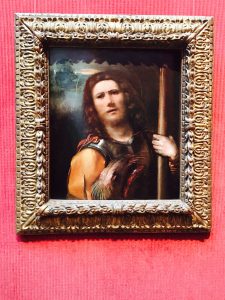 Here is a piece I wrote for the UK’s best Catholic weekly’s print edition of the Catholic Herald:
Here is a piece I wrote for the UK’s best Catholic weekly’s print edition of the Catholic Herald:
Last week in Los Angeles I visited the great Getty Museum. My attention was arrested by a 16th century Italian oil on panel by Dosso Dossi. A man in armour with a subtle halo, Christ-like hair and beard, clutches a broken spear with his white-knuckled hand. Below and before him he holds the head of a lizard bird beast. Above, a faint rainbow emerges. The man’s face is a masterwork of conflicting forces: fatigue, triumph, sorrow, determination. It was one of the most interesting paintings of the martyr St George and the Dragon that I have ever seen.
This coming week brings St George’s Feast, celebrated with solemnity as England’s Patron. His blood red Cross is emblazoned across the Union Flag. George, as the tale goes, was one of those soldier saints who, when he refused to recant his Christian Faith, was put to death perhaps in AD 303 during the reign of the Emperor Diocletian. His cult was deep and widespread. He was numbered among the Fourteen “Holy Helper Saints” and was invoked against the Black Death for the health of domestic animals. His skull is venerated in the Roman Minor Basilica of San Giorgio in Velabro which once had Bl John Henry Newman for a titular cardinal.
Speaking of dragons, the saint is most often depicted in the act of slaying one. There is little evidence of non-metaphorical dragons roaming about in the 4th century. Perhaps it was a journalist? Nevertheless, the image of St George, having captured our forebears’ minds and hearts, produced countless works of devotional art across many centuries. The kernel of the story is in the Legenda Aureaor Golden Legend of Jacobus de Voragine (d1298). Once upon a time, a venom-spewing dragon which demanded human sacrifice (as they do) plagued a town in Libya where George happened to be trotting. George declared that if they professed belief in Christ he would save the king’s daughter who had just been lead away as basilisk bait. Our saint speared the devilish critter, chopped off its head with his sword, saved the girl and, thence, a spring of disease-curing water sprang forth. The king subsequently built a church there in honor the Blessed Virgin and the saintly dragon-slayer.
At some point, we all must face the dragon. Christians strive for victory in sorrow and great fatigue, battered but determined, even when our spears have shattered.


































“Last week in Los Angeles I visited the great Getty Museum”
This reminds me. . . . This weekend my wife and I made a trip out to Mt. Angel Abbey’s bookstore and bought Saints In Art edited by Stephano Zutti and published by The J.Paul Getty Museum. At $24.95 it is a steal. Whether you are interested in saints or art, this book is a must-have. At 366 pp and copiously illustrated with informative notes on each painting, it is extraordinarily well done. Given the quality of the book, it seems like subsidized publishing by the Getty Museum. Again, it is a steal.
Meanwhile in England it is now considered racist by some to fly the flag of St. George. As the country lurches towards total atheism and cultural Marxism let us ask St. George to intercede to save this country that once had him as their patron.
I am confused. Fr. Z writes “George, as the tale goes, was one of those soldier saints who, when he refused to recant his Christian Faith, was put to death perhaps in AD 303 during the reign of the Emperor Diocletian.” When somebody says, “as the tale goes,” it means it’s probably a legend. I get the legendary story of the dragon. But is St. George’s very existence also a legend?
[You’ll figure it out.]
You were at the Getty last week! I was at the Getty last week. I didn’t see you, although it is a big place and I was only there part of one afternoon. I did see some Carmelites from Alhambra, though. Sadly, I don’t remember this particular painting (see “part of one afternoon,” supra).
Wonderful painting!
St. George, please pray for Alfie Evans and his mother and father.
I don’t remember seeing that painting before, and it would be hard to forget! Thanks for posting it.
I have been praying to St George lately for one of the countries that claim him as patron (and there are quite a few in Europe between Portugal and (of course) Georgia.
But I would really be interesting in learning about any evidence that St George was patron of England before Henry VIII “deposed” Edward the Confessor and “excommunicated” Thomas Becket. I would appreciate any hint about this subject.
I understand it was King Edward III (reigned 1327-77) who designated St. George as the patron saint of England, 200 years before Henry VIII.